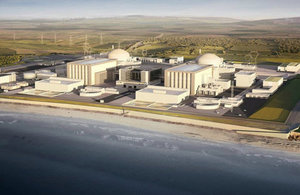Planning and managing Hinkley Point C
Contents |
[edit] Introduction
In early-2017, the Institution of Civil Engineers (ICE) hosted a networking evening with EDF Energy to discuss project planning for Hinkley Point C, the first nuclear power station in the UK in over a generation and the largest infrastructure project of the decade.
The evening featured presentations from David Speight, EDF Energy’s Head of Civil Construction, Nuclear New Build and Sarah Williamson, Laing O’Rourke Technical Director. The presentations were sought to answer some of the pressing questions the industry has regarding the project.
[edit] How can the project be delivered on cost and on time?
David Speight highlighted that previous experience of developing nuclear power plants in France meant that EDF was able to formulate a strong set of project values and culture based on lessons learned.
These values all stem from an overriding focus on quality and aim to ensure that humility, respect, solidarity, positivity and clarity permeate through the workforce. In order to facilitate this, each meeting starts with a safety message that focuses on previous examples of accidents onsite.
This approach has seen some success, as in December 2016, the Hinkley Point construction team (HPC) was able to confirm that they had one million man hours without lost time for injury.
[edit] How can HPC mitigate making construction errors onsite?
Sarah Williamson contextualised the enormity of the project by explaining that the joint venture between Bouygues and Laing O’Rourke (BYLOR) will have to produce 50 million bent bars, equivalent to the number of grass blades on three tennis courts.
She said that was why it was imperative there are no mistakes onsite as it cannot be built twice. To limit construction errors in the first instance, BYLOR decided designs need to be 3D, clash-free and buildable onsite.
In order to achieve this, they have been employing 3D modelling allowing designers to build each component of the plant virtually as many times as they need to, before creating a design they can guarantee will be successful onsite.
This approach will not only account for lowering onsite errors only but also increase efficiency rates and reduce the likelihood of health and safety issues.
[edit] What are the next steps in the project?
Both speakers stressed that in less than 50 days they will be laying the first concrete of the first nuclear new build of this generation, already a critical project milestone.
In 2017, they also have the following objectives to complete:
- Start of HPC site accommodation campus.
- First safety-related concrete used in gallery.
- Completion of east welfare building.
- Handover of civil works design studies for reactor pre-stressing gallery.
- Handover of civil works design studies for pumping station raft.
- Start installation of seawater cooling pipes.
EDF and Laing O’Rourke mentioned the importance of limiting errors. For further knowledge on health and safety see the Management of Contractors as part of ICE's health and safety series.
The EDF evening was part of ICE’s Energy, Resilience and Climate Change campaign.
This article was originally published here by ICE on 22 February 2017. It was written by Claire Miller.
--The Institution of Civil Engineers
[edit] Related articles on Designing Buildings Wiki
Featured articles and news
One of the most impressive Victorian architects. Book review.
RTPI leader to become new CIOB Chief Executive Officer
Dr Victoria Hills MRTPI, FICE to take over after Caroline Gumble’s departure.
Social and affordable housing, a long term plan for delivery
The “Delivering a Decade of Renewal for Social and Affordable Housing” strategy sets out future path.
A change to adoptive architecture
Effects of global weather warming on architectural detailing, material choice and human interaction.
The proposed publicly owned and backed subsidiary of Homes England, to facilitate new homes.
How big is the problem and what can we do to mitigate the effects?
Overheating guidance and tools for building designers
A number of cool guides to help with the heat.
The UK's Modern Industrial Strategy: A 10 year plan
Previous consultation criticism, current key elements and general support with some persisting reservations.
Building Safety Regulator reforms
New roles, new staff and a new fast track service pave the way for a single construction regulator.
Architectural Technologist CPDs and Communications
CIAT CPD… and how you can do it!
Cooling centres and cool spaces
Managing extreme heat in cities by directing the public to places for heat stress relief and water sources.
Winter gardens: A brief history and warm variations
Extending the season with glass in different forms and terms.
Restoring Great Yarmouth's Winter Gardens
Transforming one of the least sustainable constructions imaginable.
Construction Skills Mission Board launch sector drive
Newly formed government and industry collaboration set strategy for recruiting an additional 100,000 construction workers a year.
New Architects Code comes into effect in September 2025
ARB Architects Code of Conduct and Practice available with ongoing consultation regarding guidance.
Welsh Skills Body (Medr) launches ambitious plan
The new skills body brings together funding and regulation of tertiary education and research for the devolved nation.
Paul Gandy FCIOB announced as next CIOB President
Former Tilbury Douglas CEO takes helm.
























